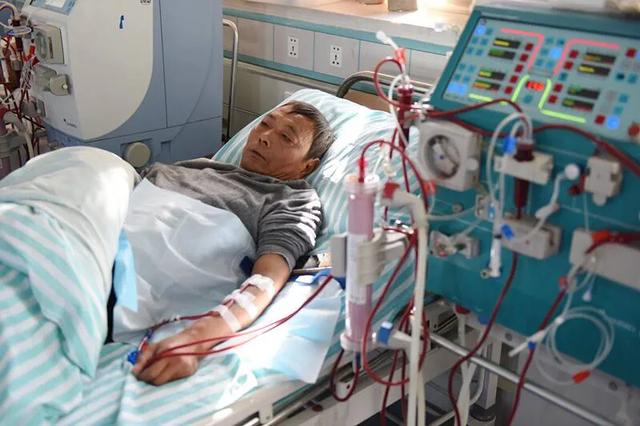How long can I live with swollen hands, feet, face, and eyelids in advanced diabetes?
In the late stages of diabetes, swelling is usually relatively serious, but it is important to distinguish the cause of the swelling.
The most common causes of edema are cardiac, renal, hepatic, malnutritional, and specialized conditions.
Patients with advanced diabetes may experience damage to multiple organs such as the heart and kidneys.
Due to the reduction of effective blood volume, the patient will develop cardiac insufficiency or failure, there is heart failure or total heart failure, there will be swelling of the hands, feet and face, which are visible, organs and other plasma cavities will also appear in the accumulation of fluid, such as pleural effusion, abdominal effusion, pericardial effusion, and other symptoms, in general the condition is more serious, and the prognosis is poorer.

Diabetic patients will develop chronic renal failure, the ability of the kidneys to form urine decreases, metabolic wastes and water cannot be excreted from the body in a timely manner, and the patient will also develop swelling and also heart failure, which will require renal replacement therapy such as peritoneal dialysis, hemodialysis, or renal transplantation to sustain life. Without dialysis, the patient will soon experience death. But after renal replacement therapy, life expectancy is basically unaffected and life and work are normal.

Some malnourished patients, combined with hypometabolism such as hypothyroidism, Silhan's syndrome, etc. may cause generalized edema, but generally the degree of edema is relatively mild, after correcting the metabolic function or strengthening the nutrition will soon return to normal.
I had a cousin's husband who was grumpy when he was younger, stuffed big drinks all day long, and beat my cousin when he was drunk.
My cousin had to put up with it for the sake of her daughter, and when the child left for work after graduating from junior high school, my cousin divorced him. After the divorce, my cousin's husband found another woman to live with him. After a few years of diabetes, the woman left, he did not take it seriously, as usual, drink and smoke, do not avoid food, not a few years time blind, can not see anything.
His daughter begged my cousin to come back to take care of her father, my cousin had no choice but to come back, to take care of him every day on time to take medication, every day to lead out for a walk, after four or five years the leg is swollen, and then slowly blackened and began to ulcerate, in the hospital for a period of time to come back, can't walk at all, can only lie on the bed, gasping for breath, sometimes he wants to curse, even open his mouth is not the strength.
Last year his condition worsened, went to the hospital hospitals refused to admit him, came back less than a month and died, only 58 years old.
It doesn't need to be so depleted.
The first step is to figure out the cause of the puffiness.

Many factors can cause swelling
There are many reasons that can cause edema, including heart disease, liver disease, kidney disease, as well as endocrine abnormalities of menopausal disorders and malnutrition.
In addition, certain medications can also cause swelling, such as adrenocorticotropic hormone, testosterone, androgens, insulin, thiourea, or licorice, which can lead to swelling of the face, hands, and feet, but generally with the cessation of the drug, the swelling phenomenon will gradually subside.
Of course, if the diabetes is advanced, heart disease and kidney disease are diabetes patients are prone to diabetes comorbidities, so we can not rule out cardiogenic edema or nephrogenic edema, the former is likely to have already occurred in heart failure, the latter is likely to have kidney dysfunction. Therefore, it is necessary to go to the hospital in a timely manner to identify the cause of the disease and treat it as soon as possible.
Symptoms of edema vary by disease
Although many diseases can cause edema, the location and symptomatic manifestation of edema varies from disease to disease and can serve as a general initial diagnosis, though of course not entirely accurate.
Nephrogenic edema: most of the swelling starts from the face and then extends to the whole body with indentation on finger pressure;
Cardiogenic edema/cirrhosis: mostly puffy from the feet with indentations on finger pressure;
Side effects of hypothyroidism or medication: can definitively have puffiness, but no indentation with finger pressure.
In addition, there will be postural edema, such as prolonged standing, walking, sitting, etc. Usually, with the change of position, the swelling can be relieved or subside after a period of time.
In reality, most edema is cardiogenic or nephrogenic. Diabetics are at high risk for heart disease and kidney disease, so be sure to pay close attention to your physical changes and seek medical attention in a timely manner.
Early detection and treatment mostly have a good prognosis, so don't be pessimistic.
Healthy Beginnings, Health Science Specialized Media, Better Life from Healthy Beginnings
This question and answer are from the site users, does not represent the position of the site, such as infringement, please contact the administrator to delete.